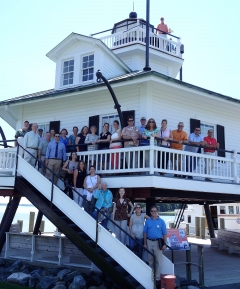Knauss legislative fellowships in Congress help build careers — and they're fun and educational. See our video and fact sheet for details.
A Lesson in Effective Storytelling About Science
The “And, But, Therefore” Approach in Action
I was in the first weeks of my Knauss Marine Policy Fellowship AND I was asked to plan a summer workshop for many NOAA employees. BUT I had never planned a workshop like this before and I wanted the agenda to be useful. THEREFORE I suggested including a short session to share a certain storytelling approach I like.
As you might have guessed, I just used this approach, called “And, But, Therefore” (ABT), in the opening paragraph. The approach got its name because a story told this way has several parts (the "AND") and poses a problem (“BUT”), creating a dramatic tension, and then (“THEREFORE”) someone finds a solution. What would my colleagues at NOAA say about this idea?
When I was elected to serve on the workshop planning committee, I was only a few weeks into my fellowship with the NOAA Fisheries Office of Habitat Conservation. And I was nervous. Not only had I never planned a workshop before, but my acronym dictionary was slowly growing and our office’s “org” chart was still a fresh sheet on my desk. It was mid-February, and this three-day workshop would be held in June for regional NOAA employees from all over the U.S. There was a lot to do before then. How would I contribute to this team and what would be my role?
At an early agenda-planning meeting, I saw an opportunity to fit this storytelling approach into our workshop. Being so new to the job, I was nervous to suggest a new agenda item. I stuck out my neck and suggested to the planning committee that we add a short session where we would introduce the concept of “And, But, Therefore” storytelling to the agenda. I briefly explained the ABT approach and shared a video by Randy Olson, a scientist turned communicator, author, and director, in which he explains the method. He authored the book Don’t be Such a Scientist, in which he outlines the best methods to relay scientific information to a public audience. I first learned that ABT storytelling approach as a graduate student at the University of Maryland. At an annual gathering of students from a consortium of remote campuses, it was introduced as a way to tell your grandma about your research. I also refreshed my ABT storytelling after participating in a science communication workshop offered by Maryland Sea Grant.
In a later meeting, the committee accepted my idea and added a session on ABT to the agenda for the three-day NOAA workshop. I felt so proud! I contributed something!
During the workshop, 10 habitat restoration teams from across the U.S. met for the first time to share challenges, best practices, and lessons learned. My short communications session was on the first day of the workshop, and we encouraged participants to develop an ABT story and then test it out on fellow participants throughout the remaining two days of the workshop. Then they would return home with a new, short pitch about their habitat restoration work. It was great to see the conference attendees working on this, but something extra and totally unexpected came out of the “And, But, Therefore” introduction.
On the third workshop day, we had a special session with NOAA leadership about our habitat restoration work. We planned the session to showcase success stories of our 10 Habitat Focus Areas, identify some of the unique challenges that each of these teams face, and leave time for meaningful discussion to get feedback from NOAA leadership.
Ultimately, the ABT story-telling approach was the perfect method for us to achieve a successful workshop session with NOAA leadership. The approach proved to be extremely effective and was executed so well by all the presenters who had learned it during that workshop. Each person highlighted some of their successes while also including one of the challenges (the “BUT”) facing their region. We had plenty of time for a productive discussion with NOAA leadership, and I could not be more pleased with this application of the ABT approach that I contributed to our workshop.
This successful leadership session during our workshop went off without a hitch thanks to the ABT approach AND I hope that our group of practitioners continues to utilize it and share it with others BUT this would not have happened had I not chimed in to suggest it during our workshop agenda planning THEREFORE I hope that, no matter how new you are to your job, you feel empowered and confident enough to share your ideas with your colleagues – you never know where it could lead.
Photo, top left: NOAA Habitat Focus Area Leadership Workshop participants on the Hooper Strait Lighthouse. The group toured the Chesapeake Bay Maritime Museum in St. Michaels, Maryland, to learn about the history of resource use in the Chesapeake Bay region before visiting the Choptank River Habitat Focus Area. Credit: Linda Shaw, NOAA.
See all posts to the Fellowship Experiences blog



